Join the tribe of Movement & Calisthenics Athletes – people just like you that are working with their own body weight to get strength, lose fat build muscle, recover from injuries and live their best lives!
When it comes to training your arms, you have a lot of options. You can use weights, machines at the gym, or even do different types of arm exercises.
The most popular, of course, is through lifting weights.🤛 Using dumbbells and barbells is the most common way of developing bigger arms, which is why other options are usually set aside.
😨But what if you want to build bigger and stronger arms without using any equipment? This article will show you how!
🎯Bodyweight training can build you muscle
First of all, let’s clarify a common misconception that you can’t build bigger muscle with bodyweight exercises.
You can build muscle with bodyweight exercises as long as you do them properly!
Although external weights are great, you can get the same results with calisthenics. The trick is to train to meet the necessary factors to stimulate growth.
☝️There are three major factors for muscle development with calisthenics or any other approach.
📌Progressive overload during training
Each workout should be more difficult compared to the last workout session. The intensity of the workout can be altered by increasing the difficulty of exercises, adding volume, reducing rest periods, adding time under tension.
If the workout isn’t getting harder, you’re not going to gain any muscle.
📌Proper nutrition through whole foods
Your progressive workout will create micro-tears in the muscle fibers, your body will be needing proper nutrition to fuel recovery and growth.
Focus on eating at a caloric surplus and high protein so you can build strength and more muscle.
📌Good sleeping habits and stress management
You grow stronger during your rest. Calisthenics workout provides the stimulus for growth but proper fuel (nutrition) and recovery are needed if you want your body to maximize muscle-building potential.
To understand more on how can you build muscle with bodyweight workout routines, check out this article below:
The best exercises for big arms: huge biceps and massive triceps
Compound calisthenics exercises
The major component of your calisthenics workout should involve compound exercises. Compound movements involve multiple muscles groups and joints with one exercise.
Compound exercises create the most metabolic and mechanical damage to our muscle fibers which in turn helps us get bigger.
The use of multiple muscle groups and joints also allows us to build maximal strength. The stronger we get, the harder exercises we can choose, the more potential we can build massive arms with our workout plan.
With this type of exercise, we tend to move towards the low reps to a medium rep range of 6 – 12. We’ll include the recommended rep ranges for each exercise.
Here are the exercises you need to focus build arm muscles. We included sample exercises for beginners to advanced so feel free to choose the level of exercise that suits your skill level.
👉 TAKE NOTE: Beginners should primarily focus on these movements since you can already get enough stimulation from these exercises rather than training arms immediately with specific triceps and bicep exercises.
Compound for beginners can already help you get bigger arms.
✅Push-ups – 3 to 4 sets of 8 to 15 reps
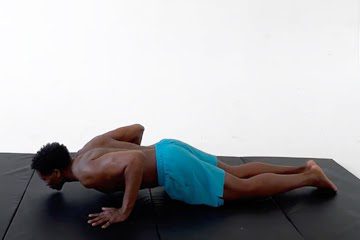
Knee push-ups for newer calisthenics athletes
Push-ups are a staple for building bigger chest muscles and also tricep muscles. Not only that, but it can also develop the front of your shoulders that makes your arms look even bigger.
For push-ups to be effective, you must be able to perform the proper form.
Lean forward as you lower down and tuck your elbows close to your body to hit the triceps more. Push back up to the starting position by engaging your triceps and chest.
Easier variation: knee push-ups, incline push-ups, incline diamond push-up, knee diamond push-up
Harder variation: Diamond push-ups, Gymnastics ring push-ups
✅Dips – 3 to 4 sets of 6 to 10 reps
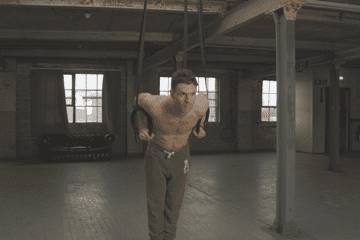
Ring dips are for more experienced individuals who have mastered the regular dips on parallel bars
If you want a stronger upper body and massive arms using your own bodyweight, dips are crucial. Although beginners might find the exercise too challenging, you can still implement the exercise in their calisthenics journey using the proper progressions.
Dips also have a good transfer to muscle-ups just in case you are interested in pursuing this skill exercise.
Easier variation: Bench dips, Band/leg assisted dips
Harder variation: Gymnastics ring dips, weighted dips
✅Chin-ups/pull-ups 3 to 4 sets of 6 to 10 reps
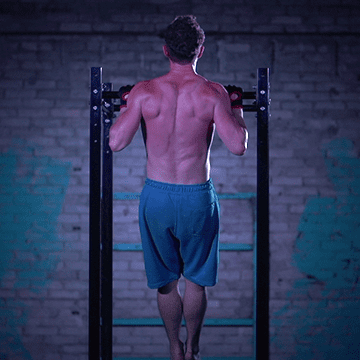
Pull-ups done with a complete range of motion and short pause at the top position for maximum gains
Want bigger back muscles while getting bigger biceps? Then this is the exercise for you.
If you’re deciding which between these two pulling exercises should you choose, the chin-up puts more emphasis on your biceps. The problem is that you would need a bit more upper body mobility to safely train your bicep while minimizing the risk of the golfer’s elbow or elbow joint pain.
Although this exercise is a calisthenics basic and should be integrated into every level of training, not everyone can do a single chin-up which is why using the correct progress is vital for progress.
Easier variation: band/leg assisted chin-ups, negatives
Harder variation: One-arm chin-ups, mantle chin-ups, L-sit pull-ups, weighted chin-ups
✅Bodyweight rows 3 to 4 sets of 12 to 20 reps
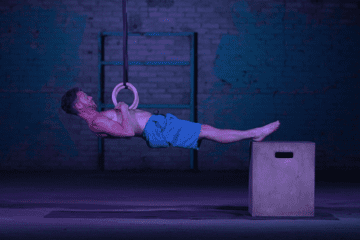
Rows can be scaled depending on body position. The lower you go, the harder the exercise.
Another bodyweight exercise that helps build a bigger back and biceps in conjunction with chin-ups is the bodyweight row AKA Australian pulls or inverted rows. This hits your pulling muscles in a horizontal fashion.
The exercise is very much easy to scale for every level and it is quite light compared to the pull-ups and chin-ups making this exercise excellent for more reps.
Easier variation: Higher angle for rows
Harder variation: Lower angle, adding weight, elevated legs, front lever row progression
Isolation calisthenics exercises
Compound exercises are undoubtedly superior for training for hypertrophy but in order to create more stimulus for bigger arms, we can implement isolation exercises to our workouts.
An isolation exercise involves a single joint in the movement. This allows you to train a single muscle group instead of multiple body parts for example isolating the biceps or triceps in our case.
Isolation works because we can focus on adding volume for our arms without getting too fatigued with our other muscle groups.
When using compounds, we tend to get tired of our bigger muscles which hinder us from directly training our arms.
For example, when using chin-ups to build the biceps, your core or lats might tire first which hinders you to perform the exercise even though your bicep can still manage to undergo loading.
This is when isolation exercises come into your training. These are best done after your major movements so you can train them to failure or high-reps for maximum muscle building potential.
✅Bicep rows 3 – 4 sets of 8 to 15 reps
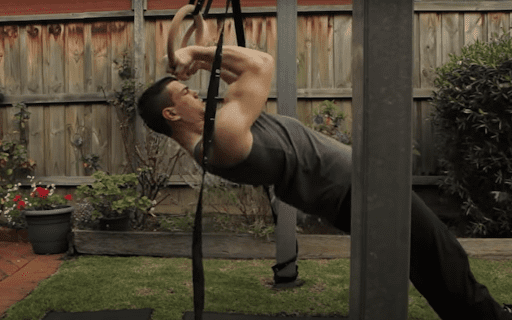
Bodyweight bicep rows courtesy of Daniel Vadnal from FitnessFAQs
Many people think that you can only build your biceps using bicep curls with weights.
No doubt bicep curls are effective as a bicep exercise which is why calisthenics has its own body weight counterpart.
Bicep rows or bodyweight bicep curls are fantastic to isolate the biceps so they can work your rows while minimizing the help from your back and lat muscles. It has a similar motion to your bicep curls of weight lifting.
The technique is quite similar to bodyweight rows but hands in a supinated grip fingers pointing towards your face like a chin-up. This puts much emphasis on your biceps when you pull.
This bicep exercise is easy to scale and expect to be doing this for a longer period of time. Tuck in your elbows as you pull to keep your shoulders and joints safe.
Easier variation: Higher angle
Harder variation: One arm bicep curl, lower angle
✅Tricep extensions
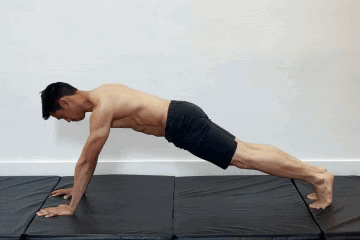
Tricep extension can be done on the floor, on an incline, or even on rings for easier scalability
A common misconception is that if you want to get bigger-looking arms, you need to work more of your biceps.
While bicep training is essential to make your arms get bigger, the triceps actually make up a bigger portion of your arms. If you focus on training your triceps, you’ll get bigger arms visibly.
Tricep extension is a key exercise for isolating the triceps. You can perform it on an incline for newer individuals then move towards a longer angle as you grow stronger.
Easier variation: Incline tricep extension
Harder variation: Lower tricep extension, gymnastics rings tricep extension
Choose the correct progression
The right progression for each exercise will generate enough intensity to meet the requirements for muscle growth. Choose them wisely.
Begin using the easiest progressions first before heading up the line to get a safe assessment of your skill.
For advanced athletes
More experienced individuals have more options with their exercise selections and workouts style.
Here are just a few things you might want to try.
🔥 Use gymnastics rings
🔥 Adding weights
🔥 Add more exercises such as ring tricep dip or pelican curls
Meet the right volume
For bigger arms, don’t be afraid to reach higher volumes for your isolation exercises or even using medium-intensity exercises for your skill level.
A good rule of thumb is to work towards near muscular failure each rep for isolation. Leave around 1 to 2 reps before you can no longer do a single rep.
At the last set of your isolation exercise, you can go to full failure to create maximum muscle tears for increased growth potential.
👊In conclusion:
Bigger arms is totally possible with calisthnics. Many people just fall into the !common myth that calisthenics can’t build muscle.
You can develop muscle and getty bigger arms with the bodyweight approach as long as you use the correct exercise and meet the proper muscle-building principles.
✊If you need any help to get gain muscle, build strength, and even more such as improve your mobility and learn new calisthenics skills, then you need to get a proper and PERSONALISED program that guides you towards that direction.
To begin your adaptive and progressive calisthenics journey, you just need to take a short assessment so you can identify the proper starting point for each exercise.
Take the first step and become a Movement Athlete.
TAKE THE ASSESSMENT NOW!
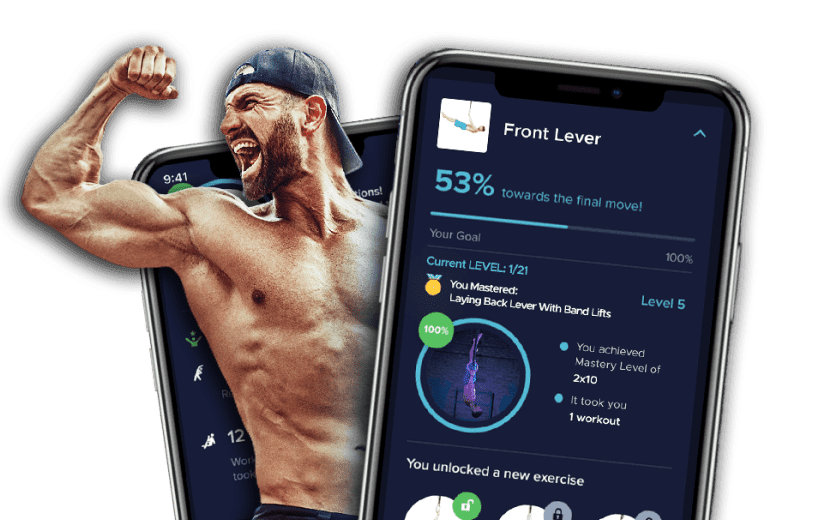
UNSURE HOW TO GET STARTED
Get a FREE personalized plan here
(No strings attached)